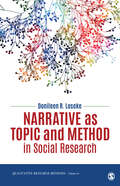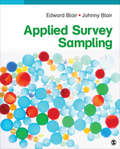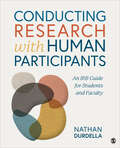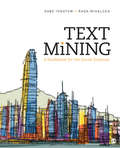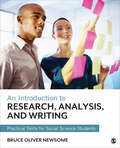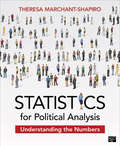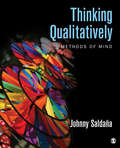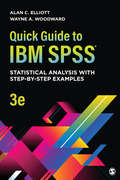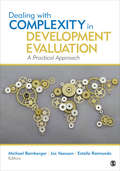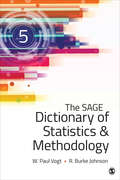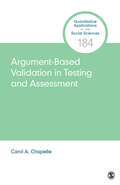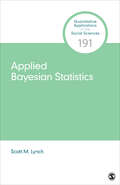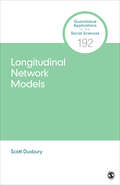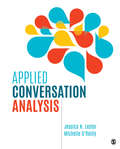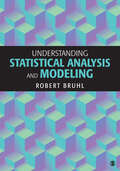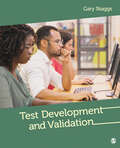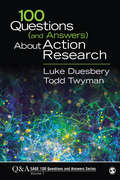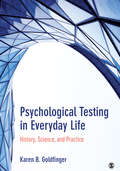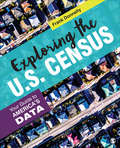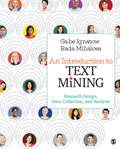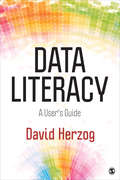- Table View
- List View
Narrative as Topic and Method in Social Research (Qualitative Research Methods)
by Donileen R. LosekeNarrative research is an increasingly popular qualitative method across the social sciences. This book has two purposes: firstly to show students and researchers how to do research on narrative topics, particularly on questions about narrative productions of meaning, and secondly to explain some fundamentals of research methods suitable for exploring these topics. A final part of the book provides empirical examples of how such research is done. These chapters use small amounts of data to examine the analytic tasks of designing research questions, finding appropriate data, sampling decisions, contextualization, data categorization, and communicating study findings.
Applied Survey Sampling
by Johnny Blair Edward BlairWritten for students and researchers who wish to understand the conceptual and practical aspects of sampling, this book is designed to be accessible without requiring advanced statistical training. It covers a wide range of topics, from the basics of sampling to special topics such as sampling rare populations, sampling organizational populations, and sampling visitors to a place. Using cases and examples to illustrate sampling principles and procedures, the book thoroughly covers the fundamentals of modern survey sampling, and addresses recent changes in the survey environment such as declining response rates, the rise of Internet surveys, the need to accommodate cell phones in telephone surveys, and emerging uses of social media and big data.
Conducting Research with Human Participants: An IRB Guide for Students and Faculty
by Nathan Richard DurdellaConducting Research with Human Participants: An IRB Guide for Students and Faculty by Nathan Durdella is the only guidebook students and faculty will need to navigate the IRB process and secure swift approval of research protocols. This book serves as an advisor to walk researchers through all the details of drafting, submission, and revision of materials for Institutional Review Boards so they can complete their research projects or dissertations faster. This text walks readers through the history of Institutional Review Boards, the contemporary context of ethical research, strategies to effectively draft, submit, and revise an IRB protocol, and guidance on working with an approved protocol in the field. The latest updates to the Common Rule and other regulatory frameworks, including special protections for working with vulnerable groups, are covered throughout the text. Not every research project goes according to plan, so adverse events and reporting receive special coverage. A final chapter on ethical research practices beyond IRB compliance encourages researchers to think through how to exit the field of research and ensure their research benefits the individuals, families, and communities in which they work. Take the guesswork out of the IRB process from start to finish with this handy guide.
Text Mining: A Guidebook for the Social Sciences
by Gabe Ignatow Rada F. MihalceaOnline communities generate massive volumes of natural language data and the social sciences continue to learn how to best make use of this new information and the technology available for analyzing it. Text Mining brings together a broad range of contemporary qualitative and quantitative methods to provide strategic and practical guidance on analyzing large text collections. This accessible book, written by a sociologist and a computer scientist, surveys the fast-changing landscape of data sources, programming languages, software packages, and methods of analysis available today. Suitable for novice and experienced researchers alike, the book will help readers use text mining techniques more efficiently and productively.
An Introduction to Research, Analysis, and Writing: Practical Skills for Social Science Students
by Bruce Oliver NewsomeThis accessible guide walks readers through the process of completing a social science research project. Written specifically to meet the needs of undergraduate research classes, it introduces students to a complete skill set, including: planning, design, analysis, argumentation, criticizing theories, building theories, modeling theories, choosing methods, gathering data, presenting evidence, and writing the final product. Students can use this text as a practical resource to navigate through each stage of the process, including choices between more advanced research techniques.
Statistics for Political Analysis: Understanding the Numbers
by Theresa Marchant-ShapiroStatistics are just as vital to understanding political science as the study of institutions, but getting students to understand them when teaching a methods course can be a big challenge. Statistics for Political Analysis makes understanding the numbers easy. The only introduction to statistics book written specifically for political science undergraduates, this book explains each statistical concept in plain language—from basic univariate statistics and the basic measures of association to bivariate and multivariate regression—and uses real world political examples. Students learn the relevance of statistics to political science, how to understand and calculate statistics mathematically, and how to obtain them using SPSS. All calculations are modeled step-by-step, giving students needed practice to master the process without making it intimidating. Each chapter concludes with exercises that get students actively applying the steps and building their professional skills through data calculation, analysis, and memo writing.
Thinking Qualitatively: Methods of Mind
by Johnny SaldañaWritten in Johnny Saldaña′s elegant and accessible style, Thinking Qualitatively: Methods of Mind boldly pursues the challenge of teaching students not just how to collect and analyze data, but how to actively think about them. Each chapter presents one "method of mind" (thinking analytically, realistically, symbolically, ethically, multidisciplinarily, artistically, summarily, interpretively, and narratively), together with applications, a vignette or story related to the thinking modality, points to remember, and exercises. Designed to help researchers "rise above the data," the book explores how qualitative research designs, data collection, data analyses, and write-ups can be enriched through over 60 different lenses, filters, and angles on social life. Venturing into more evocative and multidimensional ways to examine the complex patterns of daily living, the book reveals how the researcher′s mind thinks heuristically to transcend the descriptive and develop "highdeep" insights about the human condition.
Quick Guide to IBM® SPSS®: Statistical Analysis With Step-by-Step Examples
by Alan C. Elliott Wayne A. WoodwardA perfect supplement for an introductory statics course. Quick Guide to IBM® SPSS®: Statistical Analysis With Step-by-Step Examples gives students the extra guidance with SPSS they need without taking up valuable in-class time. A practical, accessible guide for using software while doing data analysis in the social sciences, students can learn SPSS on their own, allowing instructors to focus on the concepts and calculations in their lectures, rather than SPSS tutorials. Designed to work across disciplines, the authors have provided a number of SPSS "step-by-step" examples in chapters showing the user how to plan a study, prepare data for analysis, perform the analysis and interpret the output from SPSS. The new Third Edition covers IBM® SPSS® version 25, includes a new section on Syntax, and all chapters have been updated to reflect current menu options along with many SPSS screenshots, making the process much simpler for the user. In addition, helpful hints and insights are provided through the features "Tips and Caveats" and "Sidebars."
The Practice of Survey Research: Theory and Applications
by Brian Joseph Gillespie William E. Wagner-Huang Erin RuelUnique in its integration of theory and application, this comprehensive book explains survey design, implementation, data analysis, and continuing data management, including how to effectively incorporate the latest technology (e.g., SurveyMonkey and Qualtrics). Data management and analysis are demonstrated and explained through statistical software including SPSS, SAS, and STATA. In addition to helping students develop a complete understanding of survey research from start to finish, the authors also address the challenges and issues of specific disciplines.
Introduction to Cognitive Ethnography and Systematic Field Work (Qualitative Research Methods)
by G. Mark SchoepfleIntroduction to Cognitive Ethnography and Systematic Field Work by G. Mark Schoepfle provides a guide to the fundamentals of cognitive ethnography for qualitative research. A focus of this technique is collecting data from flexible but rigorous interviews. These interviews are flexible because they are designed to be structured around the semantic knowledge being elicited from the speaker, not around some pre-conceived design that is based on the researcher’s background, and they are rigorous because the basic linguistic and semantic structures are shared among all cultures. Written by one of the founders of this technique, this text provides a wealth of concentrated knowledge developed over years to best suit this collaborative and participant-centric research process. Eight chapters show how intertwined data collection and analysis are in this method. The first chapter offers a brief history and overview of the cognitive ethnography. Chapter 2 covers planning a research project, from developing a research question to ethics and IRB requirements. The next two chapters cover interview background, techniques, and structures. Chapter 5 addresses analysis while Chapter 6 covers transcription and translation. Chapter 7 covers observation, while a final chapter address writing a report for both consultants and outside audiences.
Dealing With Complexity in Development Evaluation: A Practical Approach
by Michael Bamberger Jos Vaessen Estelle RaimondoRecognizing that complexity calls for innovative, conceptual, and methodological solutions, this unique book offers practical guidance to policymakers, managers, and evaluation practitioners on how to design and implement complexity-responsive evaluations that can be undertaken in the real world of time, budget, data, and political constraints. Introductory chapters present comprehensive, non-technical overviews of the most common evaluation tools and methodologies, and additional content addresses more cutting-edge material. The book also includes six case study chapters to illustrate examples of various evaluation contexts from around the world.
Applied Survey Sampling
by Johnny Blair Edward BlairWritten for students and researchers who wish to understand the conceptual and practical aspects of sampling, this book is designed to be accessible without requiring advanced statistical training. It covers a wide range of topics, from the basics of sampling to special topics such as sampling rare populations, sampling organizational populations, and sampling visitors to a place. Using cases and examples to illustrate sampling principles and procedures, the book thoroughly covers the fundamentals of modern survey sampling, and addresses recent changes in the survey environment such as declining response rates, the rise of Internet surveys, the need to accommodate cell phones in telephone surveys, and emerging uses of social media and big data.
Text Mining: A Guidebook for the Social Sciences
by Gabe Ignatow Rada F. MihalceaOnline communities generate massive volumes of natural language data and the social sciences continue to learn how to best make use of this new information and the technology available for analyzing it. Text Mining brings together a broad range of contemporary qualitative and quantitative methods to provide strategic and practical guidance on analyzing large text collections. This accessible book, written by a sociologist and a computer scientist, surveys the fast-changing landscape of data sources, programming languages, software packages, and methods of analysis available today. Suitable for novice and experienced researchers alike, the book will help readers use text mining techniques more efficiently and productively.
The SAGE Dictionary of Statistics & Methodology: A Nontechnical Guide for the Social Sciences
by Robert Burke Johnson W. (William) VogtWritten in a clear, readable style with a wide range of explanations and examples, this must-have dictionary reflects recent changes in the fields of statistics and methodology. Packed with new definitions, terms, and graphics, this invaluable resource is an ideal reference for researchers and professionals in the field and provides everything students need to read and understand a research report, including elementary terms, concepts, methodology, and design definitions, as well as concepts from qualitative research methods and terms from theory and philosophy.
Argument-Based Validation in Testing and Assessment (Quantitative Applications in the Social Sciences #184)
by Carol A. ChapelleCarol A. Chapelle shows readers how to design validation research for tests of human capacities and performance. Any test that is used to make decisions about people or programs should have undergone extensive research to demonstrate that the scores are actually appropriate for their intended purpose. Argument-Based Validation in Testing and Assessment is intended to help close the gap between theory and practice, by introducing, explaining, and demonstrating how test developers can formulate the overall design for their validation research from an argument-based perspective.
Applied Bayesian Statistics (Quantitative Applications in the Social Sciences)
by Scott M. LynchBayesian statistical analyses have become increasingly common over the last two decades. The rapid increase in computing power that facilitated their implementation coincided with major changes in the research interests of, and data availability for, social scientists. Specifically, the last two decades have seen an increase in the availability of panel data sets, other hierarchically structured data sets including spatially organized data, along with interests in life course processes and the influence of context on individual behavior and outcomes. The Bayesian approach to statistics is well-suited for these types of data and research questions. Applied Bayesian Statistics is an introduction to these methods that is geared toward social scientists. Author Scott M. Lynch makes the material accessible by emphasizing application more than theory, explaining the math in a step-by-step fashion, and demonstrating the Bayesian approach in analyses of U.S. political trends drawing on data from the General Social Survey.
Longitudinal Network Models (Quantitative Applications in the Social Sciences)
by Scott DuxburyAlthough longitudinal social network data are increasingly collected, there are few guides on how to navigate the range of available tools for longitudinal network analysis. The applied social scientist is left to wonder: Which model is most appropriate for my data? How should I get started with this modeling strategy? And how do I know if my model is any good? This book answers these questions. Author Scott Duxbury assumes that the reader is familiar with network measurement, description, and notation, and is versed in regression analysis, but is likely unfamiliar with statistical network methods. The goal of the book is to guide readers towards choosing, applying, assessing, and interpreting a longitudinal network model, and each chapter is organized with a specific data structure or research question in mind. A companion website includes data and R code to replicate the examples in the book.
Applied Conversation Analysis: Social Interaction in Institutional Settings
by Jessica Nina Lester Michelle O′ReillyFocusing on applied conversation analysis (CA), this timely book offers practical insights and guidelines for CA scholars studying social interactions in institutional settings. Written in an accessible style and packed with case studies, examples, activities, and practical tips, the book takes readers through the entire process of planning and carrying out an applied CA research study. By highlighting challenges, debates, and important questions, each chapter provides the theoretical foundation necessary for making informed decisions at every stage of a research project. The book is divided into three sections (context and planning, doing a project using conversation analysis, and disseminating your research) to mirror the research process.<br
Understanding Statistical Analysis and Modeling
by Robert H. BruhlUnderstanding Statistical Analysis and Modeling is a text for graduate and advanced undergraduate students in the social, behavioral, or managerial sciences seeking to understand the logic of statistical analysis. Robert Bruhl covers all the basic methods of descriptive and inferential statistics in an accessible manner by way of asking and answering research questions. Concepts are discussed in the context of a specific research project and the book includes probability theory as the basis for understanding statistical inference. Instructions on using SPSS® are included so that readers focus on interpreting statistical analysis rather than calculations. Tables are used, rather than formulas, to describe the various calculations involved with statistical analysis and the exercises in the book are intended to encourage students to formulate and execute their own empirical investigations.
Test Development and Validation
by Gary Edward SkaggsTest Development and Validation by Gary Skaggs summarizes the latest test theories, frameworks for test development and validation, and guidance for developing tests in straightforward language in one core text. Students looking for clear, concise explanations of measurement, validity, and test development within a real-world context and with numerous examples will find this book to be an excellent learning resource. Author Gary Skaggs takes years of experience teaching test development to graduate students across social and behavioral sciences and consulting on a wide variety of government and institutional research projects to offer students a thorough, jargon-free, and highly applied book to help propel their own research and careers. Part I of the book, The Big Picture, sets the stage for test development, placing it within the larger context and history of measurement, emphasizing measurement concepts and their evolution over time. Part II, Test Development, covers the technical details of instrument and test development in logical order. Validation, Part III, links the conceptual bases provided in Part I with the technical process provided in Part II to conclude the book. For those students wanting to go further, software suggestions are referenced in the technical chapters, while Further Reading sections offer the original sources for more details. Exercises and Activities at the end of each chapter provide students a variety of ways to apply their knowledge, from conceptual questions to brief project ideas to data analysis problems.
100 Questions (SAGE 100 Questions and Answers #7)
by Luke S. Duesbery Todd M. Twyman100 Questions (and Answers) About Action Research identifies and answers the essential questions on the process of systematically approaching your practice from an inquiry-oriented perspective, with a focus on improving that practice. This unique text offers progressive instructors an alternative to the research status quo and serves as a reference for readers to improve their practice as advocates for those they serve. The Question and Answer format makes this an ideal supplementary text for traditional research methods courses, and also a helpful guide for practitioners in education, social work, criminal justice, health, business, and other applied disciplines.
Psychological Testing in Everyday Life: History, Science, and Practice
by Karen B. GoldfingerPsychological Testing in Everyday Life explores how psychological testing is used in real-life settings to make the study of psychometrics interesting, relevant, and highly accessible. Author Karen B. Goldfinger examines a broad range of carefully selected topics to capture student interest, encourage critical thinking, and spark class discussions. Organized in the form of an applied casebook, each chapter presents the complex issues that arise when using psychological tests in a variety of settings, providing an in-depth view of psychological testing practices, historically and in the present. This unique text will support students in becoming thoughtful, informed consumers and providers of psychological assessment.
Exploring the U.S. Census: Your Guide to America’s Data
by Francis P. DonnellyExploring the U.S. Census gives social science students and researchers alike the tools to understand, extract, process, and analyze data from the decennial census, the American Community Survey, and other data collected by the U.S. Census Bureau. Donnelly′s text provides a thorough background on the data collection methods, structures, and potential pitfalls of the census for unfamiliar researchers, collecting information previously available only in widely disparate sources into one handy guide. Hands-on, applied exercises at the end of the chapters help readers dive into the data. Along the way, the author shows how best to analyze census data with open-source software and tools. Readers can freely evaluate the data on their own computers, in keeping with the free and open data provided by the Census Bureau. By placing the census in the context of the open data movement, this text makes the history and practice of the census relevant so readers can understand what a crucial resource the census is for research and knowledge.
An Introduction to Text Mining: Research Design, Data Collection, and Analysis
by Gabe Ignatow Rada F. MihalceaThis is the ideal introduction for students seeking to collect and analyze textual data from online sources. It covers the most critical issues that they must take into consideration at all stages of their research projects.
Data Literacy: A User′s Guide
by David L. HerzogA practical, skill-based introduction to data analysis and literacy We are swimming in a world of data, and this handy guide will keep you afloat while you learn to make sense of it all. In Data Literacy: A User′s Guide, David Herzog, a journalist with a decade of experience using data analysis to transform information into captivating storytelling, introduces students and professionals to the fundamentals of data literacy, a key skill in today’s world. Assuming the reader has no advanced knowledge of data analysis or statistics, this book shows how to create insight from publicly-available data through exercises using simple Excel functions. Extensively illustrated, step-by-step instructions within a concise, yet comprehensive, reference will help readers identify, obtain, evaluate, clean, analyze and visualize data. A concluding chapter introduces more sophisticated data analysis methods and tools including database managers such as Microsoft Access and MySQL and standalone statistical programs such as SPSS, SAS and R.
